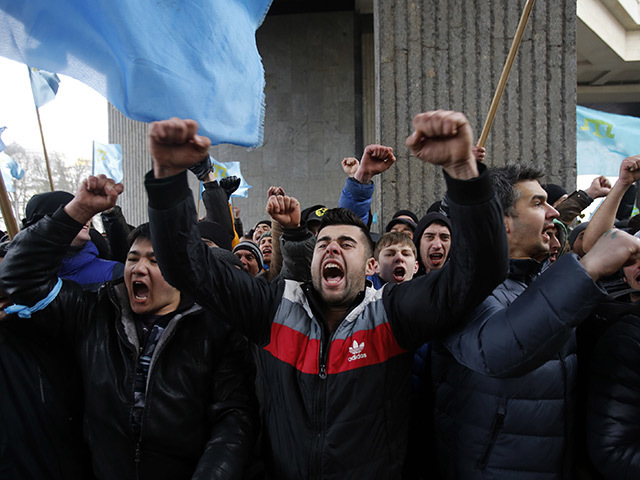
A disruption of natural gas supplies to Europe by an escalation of Russia’s military action in Ukraine may boost LNG demand and prices in Asia and South America, according to Societe Generale SA and Morgan Stanley.
Russia, which provides Europe with a quarter of its natural gas mainly though Ukraine, has cut supplies twice since 2006. While the current crisis yet to interrupt exports, liquefied natural gas prices will “move through the roof” if flows transiting Ukraine are stopped, said Thierry Bros, an analyst at Societe Generale in Paris.
The deployment of Russian troops into Crimea last weekend roiled energy markets, setting off the biggest rally in UK gas prices in 29 months and prompting Europe to import the most gas from Russia in three weeks.
Any potential supply curbs may cause traders to stop selling LNG cargoes out of storage and instead hold them for domestic use, triggering competition for the fuel in South America and Asia, according to Holmwood Consulting.
“The only way South America can get them is to outbid Asia,” said Leigh Bolton, managing director at Holmwood.
Europe could see supply threatened by an escalating conflict or if Russia decides to punish Europe for supporting Ukraine, Shane Oliver, the chief economist of AMP Capital Investors in Sydney, said in a research note March 3.
Russia shipped 505 million cubic meters of gas to Europe, excluding Baltic countries, on March 4, the highest level since Feb. 7, according to data from CDU-TEK, a unit of the country’s energy ministry.
Some LNG terminals in Europe can be used by traders to store and later reload cargoes of the supercooled gas to meet spot demand from buyers globally.
The Netherlands’ Gate terminal will probably be the first to stop selling cargoes from storage as the country supplies gas to Germany and countries further east that could demand more if Russian supplies are cut, according to Bolton. Belgium’s Zeebrugge could also stop reselling cargoes, he said.
“Germany is a large user of Russian gas, but as you move further east into the Czech Republic that’s where the exposure to Russian gas increases,” Bolton said.
LNG terminals in the European Union had a total capacity of 18.5 million metric tons a year while only importing about 6 million tons in 2012, Adam Longson, an analyst at Morgan Stanley, said in a March 3 research note.
“Import capacity should not be an issue,” Longson said. “However, the economic costs could be high.”
Rising demand and prices would put “greater strain on all LNG importing economies” in Asia, Western Europe and Latin America, Longson said.
UK gas for next month, the European benchmark, fell as much as 0.9 percent to 58.05p per therm ($9.71 per million British thermal units), down from yesterday’s close of 58.6 pence a therm on ICE futures Europe in London.
LNG to be shipped over the next four to eight weeks to buyers in Northeast Asia dropped to $18.20 per million British thermal units in the seven days ended March 3, down 6 percent from $19.40, New York-based research company Energy Intelligence Group said this week on the website of its World Gas Intelligence publication.
Japan and South Korea were the world’s two largest LNG importers in 2012, followed by Spain, India and China, according to BP Plc’s Statistical Review of World Energy.
Brazil was the biggest buyer of spot LNG in the Americas in 2012, according to the International Group of Liquefied Natural Gas Importers. The country gets 81 percent of its power from hydroelectric plants and last year sought to increase the use of fossil fuels after the worst drought in 50 years depleted reservoirs.
Recommended for you
